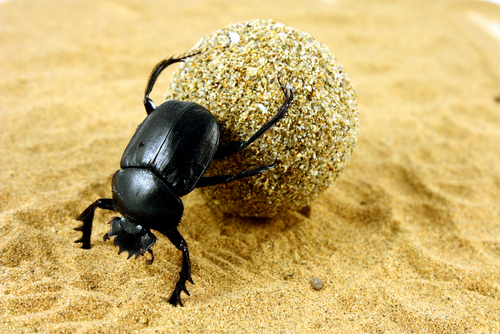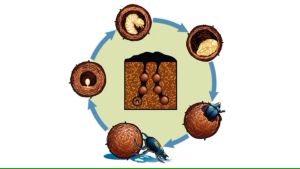Dung Beetle: Difference between revisions
No edit summary |
m The LinkTitles extension automatically added links to existing pages (https://github.com/bovender/LinkTitles). |
||
| (43 intermediate revisions by 2 users not shown) | |||
| Line 4: | Line 4: | ||
|+ !colspan="2" style="min-width:12em; text-align: center; background-color: rgb(235,235,210)|'''Scientific Classification''' | |+ !colspan="2" style="min-width:12em; text-align: center; background-color: rgb(235,235,210)|'''Scientific Classification''' | ||
|- | |- | ||
|colspan="2" |[[File:Dung-Beetle.jpg| | |colspan="2" |[[File:Dung-Beetle.jpg|400px|caption]] | ||
|- | |- | ||
!style="min-width:6em; |Kingdom: | !style="min-width:6em; |Kingdom: | ||
| Line 10: | Line 10: | ||
|- | |- | ||
!style="min-width:6em; |Phylum: | !style="min-width:6em; |Phylum: | ||
|style="min-width:6em; |Arthropoda | |style="min-width:6em; |[[Arthropoda]] | ||
|- | |- | ||
!style="min-width:6em; |Class: | !style="min-width:6em; |Class: | ||
| Line 19: | Line 19: | ||
|- | |- | ||
!style="min-width:6em; |Family: | !style="min-width:6em; |Family: | ||
|style="min-width:6em; |Scarabaeidae | |style="min-width:6em; |[[Scarabaeidae]] | ||
|- | |- | ||
|} | |} | ||
| Line 25: | Line 25: | ||
==Habitat and Range== | ==Habitat and Range== | ||
They are found on every continent except Antarctica. They can inhabit a wide variety of habitats such as deserts, grasslands | They are found on every continent except Antarctica. They can inhabit a wide variety of habitats such as deserts, grasslands, savannas, farmlands, and forests. They can thrive in many environments, from hot, dry deserts to lush forests. [2] | ||
==Behavior== | |||
These small [[insects]] are recyclers. They can help by speeding up the [[decomposition]] of dung and cycling nutrients into the [[soil]]. As mentioned, the beetles can form manure into a ball using their scooper-like head and paddle-shaped antennae. This can help control the fly population by eating dung, which reduces fly breeding grounds. During the early part of summer, the dung buries itself in the ball and feeds on it. As time passes by, the female will eventually lay her eggs in the ball of dung, on which the larvae will feed later. | |||
Many other ways can include improving soil hydrological [[properties]], reducing greenhouse gas emissions, enhancing soil [[Nutrient Cycling|nutrient cycling]], and suppressing human and livestock pathogens. [4] | |||
[[File:Dung_Beetle_LifeCycle.jpg|thumb|Stages of dung beetle Source: ABC Education [6]]] | |||
==Diet== | |||
All they eat is undigested matter in the waste of [[animals]] like cows, sheep, and camels. This is known as coprophagy (eating feces). The more fresh it is the more they like it because they can suck out the liquids from it [3]. They have sharp mouthparts that allow them to chomp through coarse droppings. [5] | |||
Different behaviors of feeding include: | |||
<li>Rollers </li> | |||
<p> Form the pat into balls that are rolled to a suitable site and buried. | |||
<li> Tunnelers </li> | |||
<p> Consume the dung pat and burrow into the soil beneath the pat. | |||
<li>Manure Dwellers </li> | |||
<p> The manure pat and deposit their eggs either in the same place or in the soil adjacent to the pat. | |||
== References == | |||
[1]The Editors of Encyclopaedia Britannica. (1998, July 20). Dung beetle | Adaptations, Behavior & Diet. Encyclopedia Britannica. https://www.britannica.com/animal/dung-beetle | |||
[2] Dung Beetle | San Diego Zoo Animals & Plants. (n.d.). https://animals.sandiegozoo.org/animals/dung-beetle | |||
[3] The Sacred Dung Beetles of Ancient Egypt | Kids Discover Online. (n.d.). Kids Discover Online. https://online.kidsdiscover.com/quickread/the-sacred-dung-beetles-of-ancient-egypt | |||
[4]Dung Beetles: How to Identify and Benefit from Nature’s Pooper Scoopers | eOrganic. (n.d.). https://eorganic.org/node/23262#:~:text=of%20pest%20flies.-,Feeding%20Behavior,Debra%20Murphy%2C%20realagriculture.com | |||
[5]UK beetles: 17 of the most spectacular and beautiful | Natural History Museum. (2020, June 10). https://www.nhm.ac.uk/discover/uk-beetles-british-most-spectacular-and-beautiful.html | |||
[6] Education, A. (2022, June 1). Life cycle of dung beetles. ABC Education. https://www.abc.net.au/education/life-cycle-of-dung-beetles/13909580 | |||
Latest revision as of 15:16, 2 May 2025
Dung Beetles are beetles that feed on feces. They can also be known as sarabs. These are the same beetles that are found in many paintings and jewelry of the sacred scarab of Ancient Egypt. The beetle rolling its ball of dung, with the ball representing the Earth, and the beetle is the sun. They are round with short wing covers (elytra) that expose the end of the abdomen. Usually dark in color, the male's head will have a curved horn at the top in some species.[1] In some species, the ball of manure can be as large as an apple.

| |
| Kingdom: | Animalia |
|---|---|
| Phylum: | Arthropoda |
| Class: | Insecta |
| Order: | Coleoptera |
| Family: | Scarabaeidae |
Habitat and Range
They are found on every continent except Antarctica. They can inhabit a wide variety of habitats such as deserts, grasslands, savannas, farmlands, and forests. They can thrive in many environments, from hot, dry deserts to lush forests. [2]
Behavior
These small insects are recyclers. They can help by speeding up the decomposition of dung and cycling nutrients into the soil. As mentioned, the beetles can form manure into a ball using their scooper-like head and paddle-shaped antennae. This can help control the fly population by eating dung, which reduces fly breeding grounds. During the early part of summer, the dung buries itself in the ball and feeds on it. As time passes by, the female will eventually lay her eggs in the ball of dung, on which the larvae will feed later.
Many other ways can include improving soil hydrological properties, reducing greenhouse gas emissions, enhancing soil nutrient cycling, and suppressing human and livestock pathogens. [4]

Diet
All they eat is undigested matter in the waste of animals like cows, sheep, and camels. This is known as coprophagy (eating feces). The more fresh it is the more they like it because they can suck out the liquids from it [3]. They have sharp mouthparts that allow them to chomp through coarse droppings. [5]
Different behaviors of feeding include:
Form the pat into balls that are rolled to a suitable site and buried.
Consume the dung pat and burrow into the soil beneath the pat.
The manure pat and deposit their eggs either in the same place or in the soil adjacent to the pat.
References
[1]The Editors of Encyclopaedia Britannica. (1998, July 20). Dung beetle | Adaptations, Behavior & Diet. Encyclopedia Britannica. https://www.britannica.com/animal/dung-beetle
[2] Dung Beetle | San Diego Zoo Animals & Plants. (n.d.). https://animals.sandiegozoo.org/animals/dung-beetle
[3] The Sacred Dung Beetles of Ancient Egypt | Kids Discover Online. (n.d.). Kids Discover Online. https://online.kidsdiscover.com/quickread/the-sacred-dung-beetles-of-ancient-egypt
[4]Dung Beetles: How to Identify and Benefit from Nature’s Pooper Scoopers | eOrganic. (n.d.). https://eorganic.org/node/23262#:~:text=of%20pest%20flies.-,Feeding%20Behavior,Debra%20Murphy%2C%20realagriculture.com
[5]UK beetles: 17 of the most spectacular and beautiful | Natural History Museum. (2020, June 10). https://www.nhm.ac.uk/discover/uk-beetles-british-most-spectacular-and-beautiful.html
[6] Education, A. (2022, June 1). Life cycle of dung beetles. ABC Education. https://www.abc.net.au/education/life-cycle-of-dung-beetles/13909580